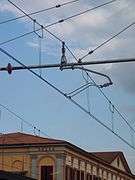catenary
English
Etymology 1
From Latin catenarius, from Latin catēna (“chain”).
Adjective
catenary (comparative more catenary, superlative most catenary)
- Relating to a chain; like a chain.
- 1997, S.A.M. Adshead, Material Culture in Europe and China, 1400–1800: The Rise of Consumerism, →ISBN:
- In Europe, the organizer was the hostess and her principle was catenary.
- 1983, Keith Godfrey, Compartmental Models and Their Application, page 242:
- The structure of the model chosen was catenary, and only one nonlinearity was introduced, in that part of the model representing bone growth.
-
- Relating to a catena.
- 1960, Kenya. Dept. of Agriculture, Soil Survey of the Songhor Area, Kenya, page 93:
- The sequence of soils of a more or less catenary nature as seen on the Martin Estate is about as follows :
-
Etymology 2
From Late Latin catenaria, in turn from Latin catēna (“chain”). Attested since 1788.
Noun
catenary (plural catenaries)
- (geometry) The curve described by a flexible chain or a rope if it is supported at each end and is acted upon only by no other forces than a uniform gravitational force due to its own weight and variations involving additional and non-uniform forces.
- (engineering) Any physical cable, rope, chain, or other weight-supporting structure taking such geometric shape, as a suspension cable for a bridge or a power-transmission line or an arch for a bridge or roof.
- (nautical) The curve of an anchor cable from the seabed to the vessel; it should be horizontal at the anchor so as to bury the flukes.
- (transport) A cable, the segments of which between supports take a catenary geometric shape, supporting in turn an overhead conductor that provides trains, trams or trolley buses with electricity, or the combination of the conductor, the cable, and supports.
- 1958, The Railway Review: An Intelligent Survey of Transit News and Trends:
- The result was catenary being torn down several hundred feet at a time.
- 1977, Paul Castelhun Trimble, Interurban Railways of the Bay Area, page 119:
- The electric overhead was catenary, using 0000 contact wire, and the new railway employed the latest in electric block signal systems.
- 1995, The Channel Tunnel: Transport systems, →ISBN, page 22:
- In addition the catenary itself is divided into 1-2 km sections (corresponding to mechanical sections or tension lengths) with motorized remotely controlled sectioning off-load isolators such that only one train is likely to be immobilized at any one time as a result of an incident associated with the catenary system.
- 2009, Jan Young, Studebaker and the Railroads, volume 2, page 47:
- Overhead construction was catenary rather than a single wire to allow the use of pantographs instead of trolley poles so that speeds could be higher.
-
Translations
curve of a flexible chain
|
curve of an anchor cable
|
|
power lines above tracks
|
Gallery
 Diagram of geometric representation of catenaries
Diagram of geometric representation of catenaries Example of a bouy floating in the water with the mooring lines being in catenary curve shapes
Example of a bouy floating in the water with the mooring lines being in catenary curve shapes Catenary cable for a railroad line.
Catenary cable for a railroad line.
Further reading




This article is issued from
Wiktionary.
The text is licensed under Creative
Commons - Attribution - Sharealike.
Additional terms may apply for the media files.